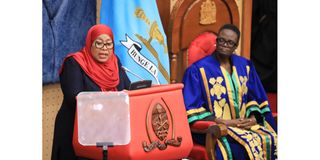Samia hails robust economic growth amid global disruptions

What you need to know:
- Despite these constraints, Tanzania’s real GDP growth rebounded significantly from an average of 3.9 percent in 2021 to 5.5 percent in 2024. The growth rate not only marked a substantial recovery but also exceeded the African continent’s average growth projection of 4 percent for the year 2024.
Dodoma. President Samia Suluhu Hassan has touted the country’s above-average economic performance over the past four years, attributing the progress to deliberate policy interventions that helped Tanzania weather global shocks and internal challenges.
In her address to Parliament on Friday, June 27, President Samia acknowledged that the path to economic growth was strewn with formidable challenges—including the lingering effects of the Covid-19 pandemic, geopolitical tensions, and supply chain disruptions caused by ongoing conflicts in various regions of the world.
“Driving economic growth under such volatile conditions has not been an easy task,” she noted.
Despite these constraints, Tanzania’s real GDP growth rebounded significantly from an average of 3.9 percent in 2021 to 5.5 percent in 2024. The growth rate not only marked a substantial recovery but also exceeded the African continent’s average growth projection of 4 percent for the year 2024.
According to President Samia, the International Monetary Fund (IMF) projects Tanzania’s economy will expand by 6 percent in 2025, reflecting growing investor confidence and improved economic fundamentals.
She reported that the country’s Gross Domestic Product (GDP) in nominal terms rose from Sh156.4 trillion in 2021 to Sh205.84 trillion in 2024. Correspondingly, the average per capita income of Tanzanians increased from Sh2,367,411 in 2020 to Sh2,938,634 in 2024, signalling enhanced household welfare and increased productive capacity.
Inflation remained subdued, averaging below 5 percent throughout the four-year period. This, the President said, was not only within the national inflation target ceiling of 5 percent but also lower than the continental inflation average.
“This inflation stability is a testament to sound fiscal and monetary policies, alongside the availability of adequate domestic food supply,” she told lawmakers.
On the external trade front, Tanzania registered a notable increase in export earnings, with the value of exported goods rising from $6.39 billion in 2021 to $8.7 billion in 2024.
The upturn in export performance bolstered the country’s foreign exchange reserves, which stood at $5.6 billion as of April 2025. President Samia emphasised that the reserves were sufficient to cover 4.5 months of import requirements—meeting the East African Community (EAC) benchmark for external reserve adequacy.
These macroeconomic indicators, she said, reflect the structural resilience of Tanzania’s economy and provide a strong foundation for the implementation of Vision 2050, which seeks to transform the country into a competitive, inclusive, and sustainable upper-middle-income economy.





